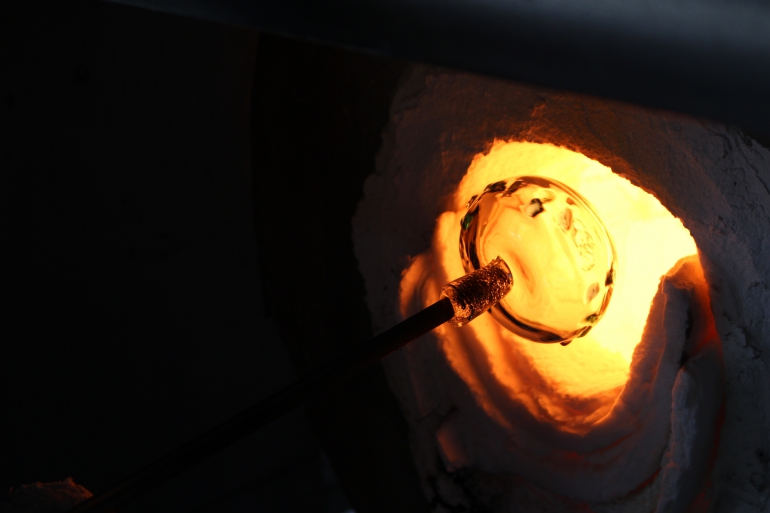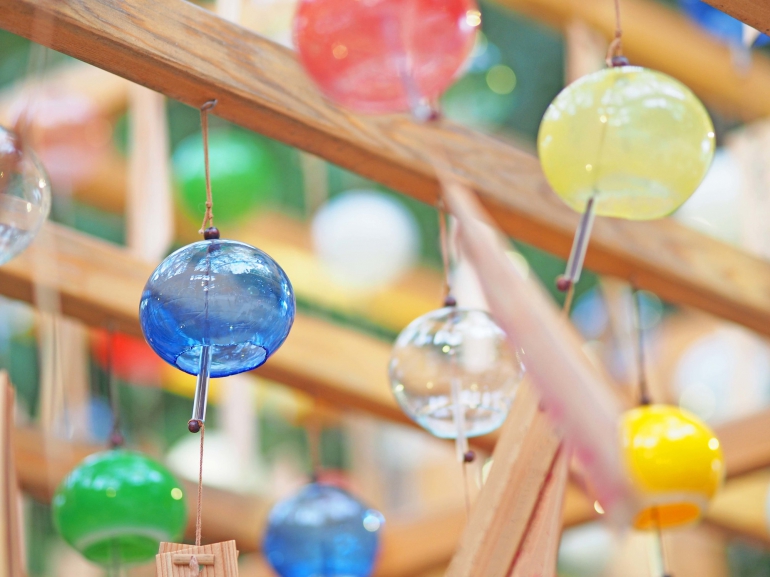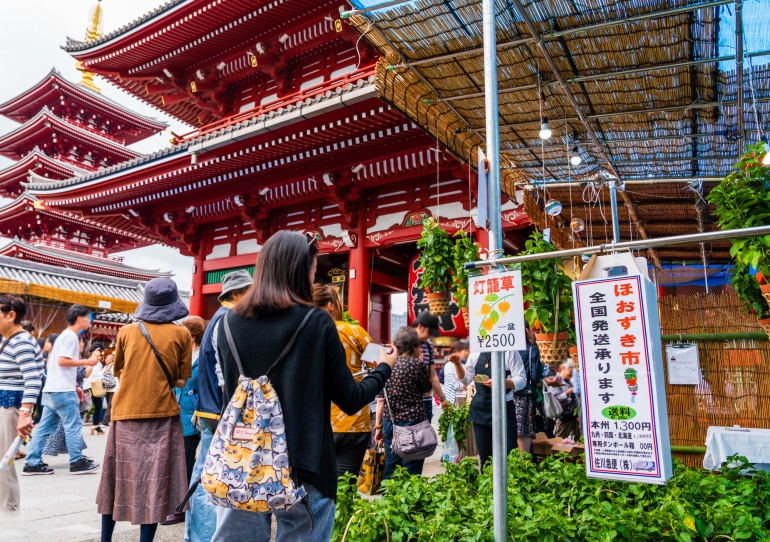- The History of Japanese Wind Chimes & their Relation to Summer
- Edo Furin: the 300 Year-Old Traditional Craft of Edo
- Where can you find Edo Furin Wind Chimes?
- Enmusubi Furin Festival (Kawagoe Hikawa Shrine: Kawagoe City, Saitama Prefecture)
- Hozuki-Ichi Market (Senso-ji Temple: Taito Ward, Tokyo)
- Conclusion
The coming of a Japanese summer is signaled by all kinds of traditions, including fireworks, festivals, bon-dancing, and Nagashi-somen (noodles served through flowing water in a bamboo half-pipe). One thing that cannot be left out is the “Furin”, a wind chime. Japanese culture perceives the soothing ring of these wind chimes to soften the fierce heat of summer. Because of the popularization of air-conditioning, wind chimes are becoming less and less common among Japanese households, but in the old times, many households would hang these wind chimes from their overhangs and windows.
This article introduces you to the history of the "furin", the Japanese wind chime, and the deep connection between its sound and Japanese culture. In particular, Tokyo has a traditional craft called the “Edo Furin” wind chime that can be purchased in several stores, and has even been designated as a historical traditional craft by the city of Tokyo. What exactly is the Edo Furin, and how is it different from a regular wind chime? This article will answer all of your questions about the Japanese wind chime.
The History of Japanese Wind Chimes & their Relation to Summer

Japanese wind chimes have been loved as being the sound of summer
For Japanese people, the gentle tinkle of wind chimes is an inseparable part of the summertime scenery. These small bells catch the soft summer breeze to produce their cooling resonance. How did they start spreading all over Japan? I will disclose that brief history to you.
Wind chimes were introduced to Japan in Nara Period (710-794CE)
Wind chimes started to be created in Japan long ago, around the Nara Period (710-794CE). It was introduced to Japan together with Buddhism by Kento-shi (a Japanese envoy to the Tang Dynasty in China).

The Japanese wind chime, "furin", began with the name "Futaku", introduced from China
The "furin" wind chime was introduced to Japan under the name of “futaku“, and originally developed as a spiritual item to ward off evil, not as a decorative bell with a cooling ring. In China, it was also used as a tool of fortune‐telling, but it was popularized in Japan as an item to ward off the “evil winds carrying misfortune, disease, and evil energy”. Even now, we can see these “futakus“ hung from the overhangs of shrines and temples in Japan.

Bronze futaku wind chime, hung at the roof edge of the temple
The Word "Furin" emerged in the Heian Period
During the Heian and Kamakura Periods(794-1333), the nobility started to hang Futaku at the edge of roofs to ward off evil spirits. During this time, Japan had no widespread culture of using glass in everyday items, and Futaku was made of bronze. It was shaped like a small temple bell, and did not have the strip of paper that swings in the wind, that is attached to the the modern wind chime. This era is said to be when the shift in naming occurred from Futaku to Furin.
The Arrival of Glass Wind Chimes & its Gradual Popularization in the Commoner Class
The first glass-made wind chime in Japan as we know it, was born in the Edo Period (1603-1868), when the technology to create fine glassware was introduced to Japan. The origin of glassware in Japan is told by several theories, one of them being that glass was first introduced into Japan through western medical equipment. These glass wares were imported through the port of Dejima in Nagasaki, and with the later popularization of glass, wind chimes also adopted glass into their craftsmanship. However, glass was extremely expensive at the time. A single wind chime costed the equivalent of 2-3 million Japanese yen today.

It was after the end of Edo period that glass-made Furin started to spread to ordinary people
As time went by, the price of glassware was finally lowered to the point where ordinary people were able to afford wind chimes. At this point, since its purpose was still to ward off evil, people then hung their wind chimes at their front doors and verandas.
A culture of enjoying wind chimes as ornaments gradually developed. This made the wind chime part of a yearly cycle in which every season's scenery is accompanied by a respective sound. During the summer, this is the wind chime; being hung in the household, it produces its soothing ring through the months of summer. Then, to greet the coming of autumn, the sound of the wind chimes is replaced by the calls of crickets. Over time, a culture regarding wind chimes as a distinct sign of summer time developed among Japanese people.
Edo Furin: the 300 Year-Old Traditional Craft of Edo
With widespread ownership of air-conditioning, people no longer have to open their windows to stay comfortable indoors in the summer. The number of households that still hear the wind chimes, swaying and chiming softly in the gentle summer breeze, has gradually decreased over the years.

A Some uniquely-shaped wind chimes
Nevertheless, there are still Furin that have been created based on methods and tradition handed down from the Edo Period. One of them is “Edo Furin“, a traditional craft of Tokyo. What are differences between Edo Furin and the common wind chime?
What are Edo Furin?
The name of “Edo Furin” indicates the making of these wind chimes in Edo - an old name of Tokyo. However, it doesn’t mean wind chimes made in Tokyo are all Edo Furin. Only 2 workshops in Tokyo are able to name their products “Edo Furin". These are “Shinohara Furin Honpo“ and Shinohara Maruyoshi Furin“. The second generation president of Shinohara Furin Honpo located in Edogawa ward, Tokyo adopted Edo period crafting methods, and established the brand of “Edo Furin” to honor its place of manufacturing.
3 characteristics of Edo Furin wind chimes
Edo Furin are the glass-made wind chimes that have become familiar to us. Although they look nothing different from regular Japanese wind chimes, there is in fact, a hidden layer of craftsmanship in them.
■ 1. The edge is left jagged intentionally
The most prominent feature of Edo Furin is its sound, distinct from most other standard Japanese wind chimes.
While the typical wind chime is characterized by the clean tinkle of two smooth, rounded surfaces colliding, the Edo Furin releases a slightly raspy, soothing resonance. The reason for that peculiar sound is its jagged edge.

The jagged edge of the wind chime
Although the edge of Furin can be smoothened by heating it with a tool such as a burner, artisans of Edo Furin leave the edge jagged. This creates greater friction between the bar and the glass, causing it to ring softly at the slightest touch.
■ 2. Edo Furin are hand-blown, one-of-a-kind pieces
Every single piece of Edo Furin is made by the hands of a glassblowing artisan. While the majority of the common wind chimes are mass-made by pouring glass into molds, Edo Furin manufacturing has inherited this 300-year old process of hand-blowing. This is why no two Edo Furins are alike anywhere in the world.

Crafting Furin by blowing the glass out of a high-heat furnace
The hand-blown method starts by melting glass in the furnace with a temperature around 1320℃. In the next 1-2 minutes before the glass cools, the artisan shapes the main component of the wind chime. Betraying my expectations that this would be a single-step process, those 1-2 minutes was filled with multiple procedures. The ringing hole, the main round component, and the string passage were all shaped in this short time. This expert craftsmanship can only be managed by artisans with skills and experience.
■ 3. The illustrations are painted from the inside
The 3rd feature of Edo Furin is the. The Furin are generally hung at the veranda or the roof edge, meaning they are used in an outdoor environment. Therefore, for Edo Furin, the artisans paint illustrations inside of Furin, so that the they will not easily fade.

The common Furin are painted from outside or their illustration is printed
Because it’s the inside of the Furin, the painting takes more time to dry, and thus the process involves repeated phases of waiting between painting session. Because of this, to paint even the simplest illustration it takes 2 to 3 days to complete. Since this is all a manual process, the more complex the illustration is, the more expensive the price is.
Where can you find Edo Furin Wind Chimes?
Edo Furin are designated as a traditional crafts of Tokyo, and as I previously stated in this article, they are currently crafted at only two places: “Shinohara Furin Honpo“ in Edogawa Ward, and “Shinohara Maruyoshi Furi“n in Taito Ward. However, there are events where you can see these special Edo Furin in Tokyo and the Kanto area.
Enmusubi Furin Festival (Kawagoe Hikawa Shrine: Kawagoe City, Saitama Prefecture)
Kawagoe Hikawa Shrine is famous for its spiritual benefits in matchmaking. At the annual summer festval, Enmusubi Furin(Enmusibi means matchmaking), Edo Furin made by Shinohara Maruyoshi Furin are displayed.

Kawagoe Hikawa Shrine
The main spot to see wind chimes here is “Furin Kairo (wind chime hallway)“, a small passage way surrounded by over 2000 wind chimes. The myriad wind chimes ring in the wind, creating an ambience that attracts many tourists to this place. It is here where we wish that our prayers, carried by the sound with the wind, will be delivered to the deity of matchmaking. This spot is visited by many couples every year, who look forward to taking pictures in this photogenic place.

The popular spot, Furin Kairo (wind chime hallway)
Although Edo Furin are not sold at Kawagoe Hikawa Shrine, the soothing sound and ambience of wind chimes is there in spades. That alone makes it a great place to visit, perhaps with a family member or loved one!
Hozuki-Ichi Market (Senso-ji: Taito Ward, Tokyo)
At Senso-ji, the temple known as the oldest temple in Tokyo, Hozuki-Ichi (Winter cherry market) is held on July 9th and 10th every year.
At this festival, a limited number of Edo Furin, made by Shinohara Furin Honpo, are sold.

Hozuki-Ichi market at Senso-ji, in Asakusa
Obviously, the main feature of this festival is the display of the vivid orange-colored Hozuki, or winter cherries. Since ancient times, folklore says that swallowing a winter cherry without chewing helps in defeating the chronic diseases of women and Kanno-mushi of babies (the bug believed to be in the stomach of babies that causes a stomach ache). Because of this belief, it has been customary to purchase Hozuki for a souvenir when visiting Senso-ji. This is how Hozuki Ichi, the winter cherry market, started here.

Displayed Hozuki and wind chimes
In order to accentuate the abundant Hozuki, many wind chimes are decorated in the premises of the temple. Although most Furin sold here are common foreign-made versions, there are a few Edo Furin made by Shinohara Furin Honpo. See if you can tell the difference in their sounds!
【Related Article】
Guide to Asakusa & Sensoji Temple! Exploring Tokyo's Old-town Charm
RELATED ARTICLE
Tokyo < Asakusa / Sky Tree

Guide to Asakusa & Sensoji Temple! Exploring Tokyo's Old-town Charm Senso-ji, located in the heart of Asakusa, is the oldest temple in Tokyo. It has a long history of over 1400 years and is we
Shrines & Temples
The Resonance of Edo Survives in Tokyo’s “Edo Furin” Wind Chimes
The Edo Furin wind chime factories, “Shinohara Furin Honpo“ and “Shinohara Maruyoshi Furin“ in Tokyo, both offer wind chime-crafting workshops. Wouldn’t it be fun to craft your own wind chime, using the traditional method handed down from the Edo Period? It is a perfect souvenir to remember Tokyo by.
Although wind chimes are becoming more rare in common Japanese households, there are still festivals and events featuring them, and wind chime markets are held every summer. Why don’t you visit these places and experience the soothing and summery sound of Furin?










_600x400.jpg)














_600x400.jpg)


